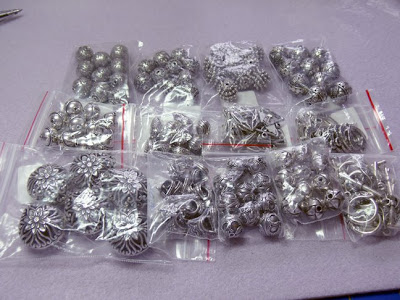Today sterling silver is over $30 an ounce.
You can almost hear the tears and gnashing of teeth of jewelry designers everywhere.
If none of this really means anything, if it’s the first you’ve heard of it, allow me to put it into perspective for you.
These are six beads I bought a week ago, wholesale. The largest is 20mm tall.
They cost me $27. Wholesale.
Two years ago, the beads below, also wholesale, cost me $400. Then, I was shaking my head and half-numb at the cost of $15/ounce. Now? They’d cost me double.
Many of my bracelets have four to five silver beads and a large silver toggle in the mix, so doing the math …..yikes. What are designers who use primarily sterling silver to do? Customers traditionally don’t like change, and switching to plated silver or another metal doesn’t always work.
 |
| The ten year silver price chart. |
|
|
|
|
Why is it so high?
Some say it started when China launched precious metal futures trading in January 2008. Some say it’s due to silver riding the coat tails of gold’s meteoric rise to over $1000/ounce. And of course historically, precious metals go up when the dollar is down.
So what does this mean for jewelry designers?
It means we’re going to have to work even harder to create unique things. Let’s take this financial hit on our supplies as an opportunity to push ourselves creatively. We can continue to use sterling silver, but perhaps less of it. Instead, we can start looking at beads we may never have considered before.
 |
| bracelet with ceramic, wood, and lampwork glass, sterling silver wire and toggle, linked with steel rings |
In some of my jewelry, instead of using the four or five silver beads I used to, I choose a pretty toggle, ONE sterling silver bead, and make the rest of the bracelet REALLY count. The toggle is as important as the beads I choose, and focusing on it as part of the whole, making sure it blends with the entire design, is even more important now.
While my customers have been slow to accept copper and brass (which pains me, as there are so. very. many. gorgeous options out there), I’ve found that by mixing it in slowly with my usual style, it’s started to be picked up more often. If you’re meeting resistance to switching metals, adding things in slowly while continuing to use your regular elements (lampwork glass, polymer clay, ceramic) might be a good way to introduce these versatile, beautiful options.
Two years ago, I thought, “Surely this can’t last!” And yet here we are. In 1980, sterling silver rose to an all-time high of $49.45 an ounce. I certainly hope we’re not headed there. HOWEVER — I do believe that we as designers are creative enough and resourceful enough to make the most of this. We can not only educate our buyers as to why certain pieces now cost more, but can attract customers with our new-found creativity born of necessity.
So look at this high rise in sterling silver cost as a challenge to you to work outside your comfort zone. Look at your beads in an entirely new way. Discover new metals. Investigate steel, pewter, and aluminum for a silver color, and view copper and brass with a new eye. Look at your toggles and clasps not merely as a way to close a piece, but as an integral part of your design.
How have you been dealing with the high rise in the cost of sterling silver?







